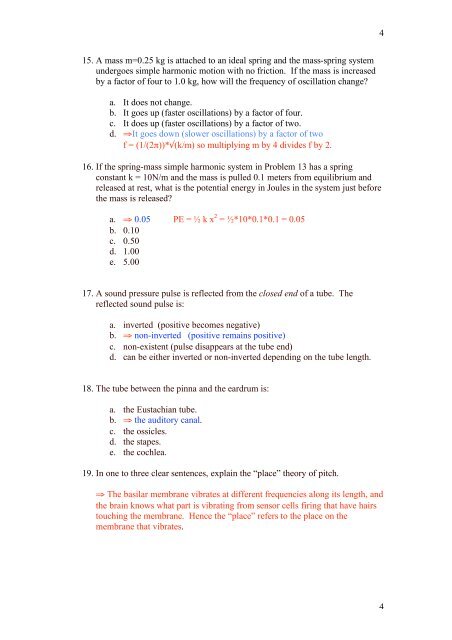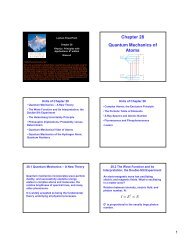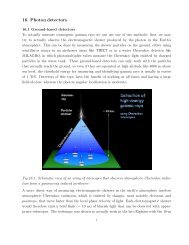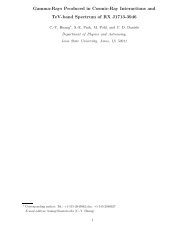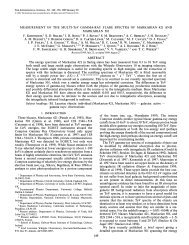1 1 Physics 198 Final Exam-Solution December 16, 2008 The exam ...
1 1 Physics 198 Final Exam-Solution December 16, 2008 The exam ...
1 1 Physics 198 Final Exam-Solution December 16, 2008 The exam ...
You also want an ePaper? Increase the reach of your titles
YUMPU automatically turns print PDFs into web optimized ePapers that Google loves.
4<br />
15. A mass m=0.25 kg is attached to an ideal spring and the mass-spring system<br />
undergoes simple harmonic motion with no friction. If the mass is increased<br />
by a factor of four to 1.0 kg, how will the frequency of oscillation change?<br />
a. It does not change.<br />
b. It goes up (faster oscillations) by a factor of four.<br />
c. It does up (faster oscillations) by a factor of two.<br />
d. ⇒It goes down (slower oscillations) by a factor of two<br />
f = (1/(2π))*√(k/m) so multiplying m by 4 divides f by 2.<br />
<strong>16</strong>. If the spring-mass simple harmonic system in Problem 13 has a spring<br />
constant k = 10N/m and the mass is pulled 0.1 meters from equilibrium and<br />
released at rest, what is the potential energy in Joules in the system just before<br />
the mass is released?<br />
a. ⇒ 0.05 PE = ½ k x 2 = ½*10*0.1*0.1 = 0.05<br />
b. 0.10<br />
c. 0.50<br />
d. 1.00<br />
e. 5.00<br />
17. A sound pressure pulse is reflected from the closed end of a tube. <strong>The</strong><br />
reflected sound pulse is:<br />
a. inverted (positive becomes negative)<br />
b. ⇒ non-inverted (positive remains positive)<br />
c. non-existent (pulse disappears at the tube end)<br />
d. can be either inverted or non-inverted depending on the tube length.<br />
18. <strong>The</strong> tube between the pinna and the eardrum is:<br />
a. the Eustachian tube.<br />
b. ⇒ the auditory canal.<br />
c. the ossicles.<br />
d. the stapes.<br />
e. the cochlea.<br />
19. In one to three clear sentences, explain the “place” theory of pitch.<br />
⇒ <strong>The</strong> basilar membrane vibrates at different frequencies along its length, and<br />
the brain knows what part is vibrating from sensor cells firing that have hairs<br />
touching the membrane. Hence the “place” refers to the place on the<br />
membrane that vibrates.<br />
4


